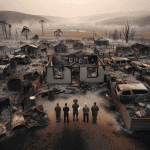Introduction: A Significant Milestone in Australia’s Bushfire Battle
Australia is no stranger to bushfires, with its arid landscapes and hot climate creating ideal conditions for such natural disasters. In recent weeks, the country faced another intense battle against fiery infernos that tested both human resilience and environmental strength. However, in a major relief, a large-scale bushfire raging for over three weeks has finally been successfully contained.
This comes as a significant victory for the communities, firefighters, and authorities involved in suppressing the blaze. The recent containment is a testament to the coordinated efforts by experts and local responders to mitigate what could have been an even more devastating disaster.
A Recap of the Bushfire’s Severity
For over three weeks, Australia grappled with a massive bushfire that scorched thousands of hectares. With flames consuming vegetation, threatening homes, and displacing wildlife, this bushfire became a cause of concern not just locally but globally, as climate advocates watched the situation unfold.
Key Highlights of the Bushfire
- The bushfire spread across an extensive area, covering thousands of hectares.
- Homes were threatened, prompting evacuations in vulnerable zones.
- A significant impact was reported on biodiversity, with local fauna and flora suffering the consequences of the fire.
- Unpredictable wind patterns and dry conditions made firefighting efforts even more challenging.
This particular bushfire gained international attention due to its scale and the broader implications it brings for climate change and sustainable land management.
Challenges Faced During the Containment Efforts
Bushfire management is inherently complex, requiring significant resources, strategy, and human power. This containment operation was no different, and authorities reported several obstacles throughout the three-week endeavor.
1. Unfavorable Weather Conditions
Australia’s notoriously dry weather played a major role in fueling the flames. Coupled with strong winds that changed directions unpredictably, this created a dangerous environment for both the firefighters and surrounding communities.
2. Resource Allocation
From water tankers to aerial firebombers, resource allocation needed to be conducted with utmost precision. However, the sheer scale of the fire stretched available resources thin, forcing responders to prioritize the most vulnerable areas.
3. Protecting High-Risk Areas
Homes, farms, and ecologically sensitive zones required targeted protection. Ensuring swift evacuations and implementing strategic firebreaks presented a significant logistical challenge.
The Role of Firefighters and Volunteers
One of the most notable aspects of this operation has been the selfless dedication of firefighters, both professional and volunteer, who worked tirelessly to contain the blaze. Their bravery and expertise were instrumental in achieving this containment.
What Made Their Efforts Stand Out?
- 24/7 shifts: Fire crews worked around the clock, often in grueling conditions.
- Use of advanced technology: Thermal imaging sensors and aerial patrols helped map the fire’s spread.
- Community collaboration: Local volunteers supported efforts by providing food, shelter, and logistical assistance.
Their unwavering commitment highlights the critical importance of a unified approach during natural disasters. Firefighters were not just protecting property but safeguarding lives and precious ecosystems.
The Environmental Impact of the Bushfire
While the containment of the fire is a massive victory, the aftermath paints a grim picture of how destructive bushfires can be for the environment.
Damage to Biodiversity
Australia is home to unique flora and fauna, many of which are highly sensitive to ecological disruptions. The bushfire left behind:
- Burned habitats: Many animals lost their natural environments, endangering their survival.
- Loss of plant species: Native vegetation, vital for local ecosystems, was greatly affected.
- Air quality degradation: Smoke from the fire caused a spike in air pollution, impacting both humans and wildlife.
Long-Term Effects on Land
Burned lands require significant time to recover. Without adequate rainfall, the risk of soil erosion and desertification increases, which could hamper future vegetation regrowth.
Community Resilience: A Beacon of Hope
Natural disasters often bring out the best in human spirit, and this bushfire was no exception. Communities in the vicinity exhibited inspiring resilience and solidarity, banding together to navigate this difficult period.
Actions Taken by Local Communities
- Evacuations: Residents cooperated with authorities, ensuring a safe evacuation for all impacted areas.
- Fundraising efforts: Donations poured in from across the country to support fire victims.
- Wildlife care: Volunteers offered their time to rehabilitate injured animals and transport them to safer zones.
The willingness of people to step up and support one another remains a silver lining in an otherwise challenging situation.
Measures to Prevent Future Bushfires
While bushfires are a natural part of Australia’s ecosystem, their frequency and intensity have increased in recent years, a concerning trend linked to global climate change. Experts and policymakers are urging immediate action to minimize the risk of similar disasters in the future.
1. Controlled Burns
Prescribed or controlled burns help reduce excessive vegetation and minimize fuel for potential bushfires. Increasing the frequency and scope of these burns can prove beneficial.
2. Investment in Firefighting Resources
Governments must allocate higher budgets for firefighting resources, including better equipment, training, and the expansion of volunteer firefighter programs.
3. Public Awareness Campaigns
Educating communities on fire safety—such as creating firebreaks, identifying escape routes, and maintaining vegetation around properties—can significantly improve preparedness during bushfire season.
4. Tackling Climate Change
More aggressive policies to combat climate change are essential. Reducing greenhouse gas emissions and taking steps to mitigate global warming can help lessen the conditions that lead to frequent bushfires.
Conclusion: A Testament to Collective Efforts
The containment of the major Australian bushfire after three weeks is a moment of relief and reflection. While the event highlighted the challenges posed by natural disasters, it also showcased the power of collective action, technological advancements, and unwavering determination.
As Australia rebuilds and restores in the wake of this fire, it serves as a poignant reminder of the need to prioritize environmental sustainability and disaster preparedness. With proactive measures, the hope remains that future bushfires can be better controlled, protecting the land, wildlife, and people that make Australia so extraordinary.


